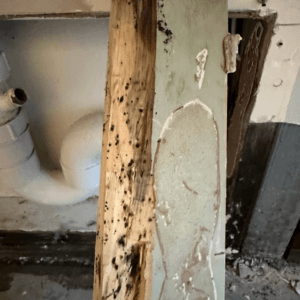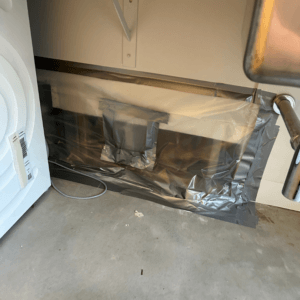Case Study: Mould Remediation with AllAces
Case Study: Mould Remediation with AllAces
Client: Domestic
Project: Laundry Leak
Service: Mould Remediation
The Challenge
In May 2023, AllAces Cleaning & Restoration was called in to handle the mould remediation of a client whose washing machine had been leaking, causing initial water damage before developing into a substantial mould infestation. The mould had affected the wall and interior wooden framing of the laundry and conjoining hallway, requiring immediate action.
The Solution
The AllAces technicians got to work stripping out the affected building materials from the laundry and hallway to ensure access to all possible mould growth. All timber framing was then treated with an advanced peroxide-based disinfectant, to ensure the eradication of mould and decontamination of the infectious environment. A containment barrier was then installed with a hydroxyl generator exhausting into the wall cavity, with an air scrubber also onsite to effectively complete the mould remediation.
The Outcome
After the fast and efficient work of 2 specialist technicians, onsite for 1 day of treatment, the mould remediation was successfully completed. Our highly trained and experienced technicians safely returned the space to a pre-loss condition and a clean and healthy home for our client.
Why Choose AllAces?
AllAces Cleaning & Restoration has more than 35 years of industry experience, specialising in mould remediation for domestic clients to large-scale commercial projects. Our IICRC-certified technicians ensure a professional, genuine, and reliable service every time. Servicing Brisbane, Sydney, Melbourne, and surrounds, we’re here to help!
Contact the team at 1800 00 10 10 today!
FAQs
What causes mould growth?
Mould grows from moisture, oxygen, and organic material. Common causes include leaks, high humidity, flooding, and poor ventilation.
How can I identify a mould problem?
Signs include visible mould patches, musty odours, health symptoms, or a history of water damage. If unsure, consult a mould inspector.
How do you remove mould properly?
Ideally, the remediation process should involve a professional assessment, area containment, air filtration using HEPA filters, removal of mouldy materials and disinfecting surfaces, drying and repair to prevent recurrence, post-removal testing and protection during cleanup, such as masks and gloves, is vital.




